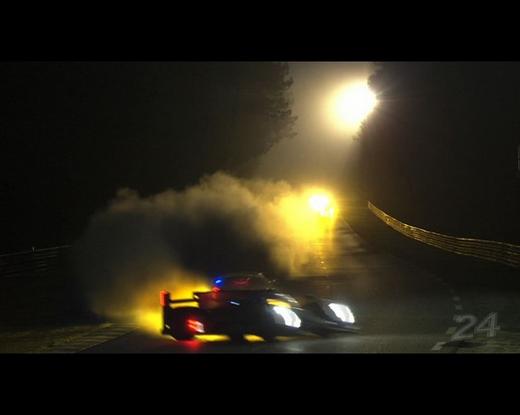Audi # 3 - Allan McNish
LAP 15: Just after the Dunlop bridge, McNish clips the much slower GT PRO Ferrari of Anthony Beltoise whilst attempting to pass on the inside as the Ferrari moved to take the approaching ride hand curve in the track. Despite the greater speed advantage, TV replays showed there never appeared to be enough room for McNish to execute the manoeuvre without making contact with the Ferarri, which he did...
His car careered off the track and travelled unhindered across the gravel trap and into a tyre wall where it was launched vertically and almost cleared the catch fencing before pirouetting dramatically back down onto track side.
After a close battle in the last few hours of the race, the fate of the race came down to the final pit stops. Andre Lotterer in the #2 R18 had a large enough lead that he was able to pit without losing track position to the Peugeots. The Audi had a 40 second lead after a pit stop, but started to develop problems with the fuel tank. The full 65-liter capacity could not be used. Audi was forced to make another pit stop and decided to change tyres, while Peugeot brought Simon Pagenaud's #9 car in for just fuel in order to close the gap to the remaining R18. The Audi stop was longer but Lotterer's Audi nevertheless left the pit lane just seconds ahead of the Pagenaud's Peugeot. On fresh tyres, Lotterer was able to pull away gradually and crossed the finish line just 13.854 seconds ahead of Pagenaud.
The final lap was the first full race speed final lap (as opposed to the traditional staged photo-finish) since that of the 1969 race, due to the small gap between the two lead cars, and the race was the 4th closest in the history of the Le Mans 24 Hours.
His car careered off the track and travelled unhindered across the gravel trap and into a tyre wall where it was launched vertically and almost cleared the catch fencing before pirouetting dramatically back down onto track side.
Despite the extensive damage to the car and force of the impact, McNish was able to to climb out of the cockpit himself and after a hospital check up, declared to be OK. It was also quite miraculous that no marshals or photographers were injured as the car disintegrated and scattered debris in all directions, including a tyre that narrowly missed a photographer.
Two videos of McNish's crash; the first from a TV broadcast, the second from a spectator, which gives a greater indication of the speed at which the R18 impacted the tyre wall.
Audi # 1 - Mike Rockenfeller
Nearly seven hours after Allan McNish's dramatic crash, Audi suffered another devastating blow in an eerily similar accident, this time involving Mike Rockenfeller's #1 R18 TDI. Like McNish's crash, Rockenfeller was attempting to overtake a slower, GTE-class Ferrari, which caught the Audi's left rear between Mulsanne and Indianapolis. The contact sent Rockenfeller's R18 abruptly into the barrier, demolishing the car.
Like McNish, Rockenfeller was thankfully able to exit the wreckage of the R18 on his own, citing little more than a small cut on his arm. Again, an amazing display of the safety measures employed by Audi's designers and engineers.The demolished R18 is taken away on a rescue truck by track marshals. The race was run behind the safety car for over 2 hours because of massive damage to the barriers from the crash. For the first time ever at Le Mans, the safety car ran low on fuel and had to be replaced.
Audi # 2 - Marcel Fässler, Benoît Tréluyer, André Lotterer
Following the crashes to car # 1 & # 3 an incredibly tight race developed between the remaining Audi and the three works Peugeots. The lead Audi and Peugeot pack were never far apart. It appeared that while the Audi R18 couldn't run as far as the Peugeot on a tank of fuel, its tyres could last 4 stints, while the 908's could only last 3, a direct result of the low-drag design. All 4 cars were leapfrogging each other pitstop after pitstop.
There was also a breathtaking overtaking manoeuvre by Benoît Tréluyer, where he used a wide run off area of the track and the slow pace of a back marker to appear from nowhere, and power back in front of one of the Peugeots.
After a close battle in the last few hours of the race, the fate of the race came down to the final pit stops. Andre Lotterer in the #2 R18 had a large enough lead that he was able to pit without losing track position to the Peugeots. The Audi had a 40 second lead after a pit stop, but started to develop problems with the fuel tank. The full 65-liter capacity could not be used. Audi was forced to make another pit stop and decided to change tyres, while Peugeot brought Simon Pagenaud's #9 car in for just fuel in order to close the gap to the remaining R18. The Audi stop was longer but Lotterer's Audi nevertheless left the pit lane just seconds ahead of the Pagenaud's Peugeot. On fresh tyres, Lotterer was able to pull away gradually and crossed the finish line just 13.854 seconds ahead of Pagenaud.
The final lap was the first full race speed final lap (as opposed to the traditional staged photo-finish) since that of the 1969 race, due to the small gap between the two lead cars, and the race was the 4th closest in the history of the Le Mans 24 Hours.














